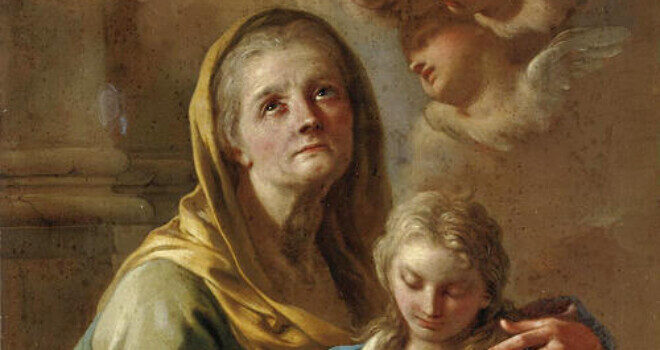I visited England in 2023. My itinerary included many churches, but a statue in one of them caught my eye. And I didn’t see it just once but a few different times. It depicted St. Anne, and she was holding in her hands the child Mary and the infant Jesus. I took a double take the first time, and even the second.
As I looked at it, I recalled The Mystical City of God by Venerable Maria of Agreda, which I read daily and comment on in my podcast. I vividly remembered that Maria of Agreda wrote that Joachim and Anne both died while Mary was in the temple. This stood out in my mind because it meant that Jesus never met His maternal grandparents. I couldn’t reconcile the statue with these facts.
However, this experience led me to ask the question: what exactly do we know about St. Anne, the mother of Mary, the grandmother of Jesus?
Anne’s and Joachim’s names are not mentioned in the Bible, so the accounts of their lives come to us extra-canonically. Their names are referenced in an apocryphal, early Christian text known as the Protoevangelium of James. The Protoevangelium was not included in the canon of Scripture because its recorded accounts seem unrealistic and fantastical. For example, one of its stories describes the maiming of a midwife who disbelieves the perpetual virginity of Mary. While some of its stories are dismissed, the Protoevangelium is referenced as a legitimate source text for at least two things: the names of Joachim and Anne and the Presentation of Mary in the Temple. So it can’t be all bad then!
Besides the Protoevangelium of James, we can also learn of St. Anne from The Life of the Virgin, by St. Maximus the Confessor, and from two mystical biographers, Venerable Maria of Agreda (mentioned above) and Blessed Anne Catherine Emmerich.
Protoevangelium of James
St. Anne is mentioned fifteen times in the Protoevangelium of James. The principal references relate to the conception of Mary—how Anne and Joachim were barren, how both prayed for a child, and then God gave them Mary. The Protoevangelium does not provide any other details of Joachim’s and Anne’s life, nor does it record when they died.
The Life of the Virgin by Maximus
St. Anne has very few references in Maximus’ text. The author seeks to bring together many of the traditions that surrounded Our Lady in the first few hundred years of Christianity. There are a total of eight references to Anne, all referring to her motherhood of Mary. No mention of the rest of her life is made.
The Mystical Biographies
It is the mystical biographies from two holy women that offer insight into the last years of the lives of Mary’s parents. As mentioned above, Maria of Agreda writes that Joachim died while Mary was in the temple, and Anne soon followed. Maria of Agreda writes that Mary was told by angels that her mother would soon die. The angels transported Mary spiritually from the temple, so that she could be mystically present with her mother at the time of her death. The details, as Maria of Agreda describes them, are beautiful, including a prayer that Mary offered to the Eternal Father for her mother (volume 1, paragraph 718).
Now, Anne Catherine Emmerich’s The Life of Jesus Christ and Biblical Revelations contradicts Maria of Agreda’s account in many ways, bringing into question the authenticity of both accounts and forcing readers to choose one over the other. In one point of difference, Anne Catherine Emmerich claims that Anne was alive during the time of Jesus’ birth and interacted with her divine grandson. Another difference in her account is that Mary is not the only child of St. Anne; Anne and Joachim had several children, including one before Mary was born. These assertions contradict the Protoevangelium of James where Anne laments her barrenness. Anne Catherine Emmerich also claims that after Joachim died, Anne remarried and went on to have other children as well. Suffice to say, Anne Catherine Emmerich presents a story of Anne that is far different from the one that we might expect.
Reconciling the Accounts
Maria of Agreda lived from 1602 to 1665, while Anne Catherine Emmerich lived from 1774 to 1824—a little over a century apart. Surprisingly, the theories of Anne Catherine Emmerich were not new to her time; they were already being circulated at the time of Maria of Agreda. Maria acknowledges the theory, confirming its presence in the 17th century but thoroughly dismisses it:
Concerning this great and admirable woman, as I have been informed, some grave authors assert, that saint Anne was married three times and that in each one of these marriages she was the mother of one of the three Marys; others have the contrary opinion. The Lord has vouchsafed to me, solely on account of his goodness, great enlightenment concerning the life of this fortunate saint; yet never was it intimated to me that she was ever married except to saint Joachim, or that she ever had any other daughter besides Mary, the Mother of Christ. (Vol 1, paragraph 724)
We can conclude that the histories of St. Joachim and St. Anne come to us from tradition. As such, there are bound to be differing legends handed down, as seen in these mystics’ accounts of St. Anne’s life. Each mystical biographer is a recipient and communicator of tradition, but the modes of their receptions of it impact their mystical revelations. At times, the revelations came in visions, other times through interior locutions, and still others by the fruit of their own imaginative and discursive meditation.
While only one account is correct, it doesn’t necessitate discarding the revelations of the other. I can say that Anne Catherine Emmerich challenged my own beliefs about the parents of Mary and grandparents of Jesus. Despite the different traditions though, the powerful intercession of St. Anne remains, as do our devotions to her. We remain faithful believers of our Lord, Blessed Lady, and St. Anne—regardless of the final details of her life on earth. Perhaps that is why our infinitely wise God did not include the details of her life in Sacred Scripture.
de Mura, F. (c. 1770). Saint Anne and the Virgin Mary [painting]. Retrieved from FineArtAmerica.










